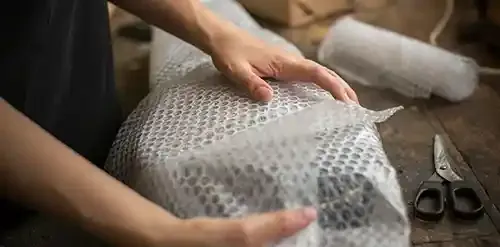Hyundai Motorstudio Senayan Park
Hyundai Motorstudio Senayan Park
Newsroom
The official news from Hyundai Motorstudio Senayan Park and a collection of innovative articles on mobility and sustainability here.
-
6 Eco-Friendly Packaging Materials Substitute for Bubble Wrap
- Hyundai Motorstudio Senayan Park Senayan Park 2022.05.27
-
Did you know that the United Nations (UN) predicts that by 2050, there will be more plastic in the oceans than fish? This prediction is really concerning as if it were a hard slap so that we immediately reduce our use of plastic. If you work in the retail sector, especially buying and selling online, one of the ways we can limit the use of plastic is to use a substitute for bubble wrap.
Why is that? Since its conception in the 1950s, bubble wrap has been one of the most popular packaging materials. The material is made of see-through plastic covered with tiny air bubbles. Bubble wrap is light, very protective, and even fun to squeeze.
It can be used to wrap fragile items so they are not easily broken or shaken. In addition, bubble wrap also provides good cushioning and fills gaps in the packaging. As a result, many brands or companies have been actively using bubble wrap for packaging for years.
Seeing the terrible impact of using bubble wrap, it's time to find a substitute for bubble wrap that is more environmentally friendly. Check out the list below!
1. Biodegradable mailer
What are mailers? For those who are new to the term "mailer," usually, a mailer is a kind of textured and soft envelope for sending small items.
Generally, mailers are made of plastic or paper bags covered with bubble wrap. However, nowadays there are many mailer manufacturers who make replacements for bubble wrap to make it more environmentally friendly and recyclable. Eco-friendly mailers are made from plants and can be used as compost.
Mailer compost can be decomposed by the soil within 180 days. What's more, the mailer can also be recycled with LDPE (low-density polyethylene) material.
2. Corrugated cardboard
Corrugated cardboard packaging is made of three sheets of paper. A fluted sheet is sandwiched between two layers. These papers are designed to be more flexible and can be used for product packaging.
Corrugated cardboard was invented in the mid-19th century when it was used to keep products upright and straight. Now its use is more varied and it is used by about 90% of all products throughout the United States.
It is made of 100% recyclable and reusable materials. Because the cardboard packaging uses fast-growing pine and birch trees, which are then processed into corrugated cardboard.Corrugated cardboard packaging is widely chosen because it is durable and lightweight. In addition, it tends to be cost-effective, environmentally friendly, and easy to recycle.
3. Biodegradable packaging
Since the styrofoam ban in the 1990s, many companies have turned to biodegradable packaging. This packaging is made of cornstarch, which is very similar to styrofoam.
Not only does it perform similarly to Styrofoam in terms of function, but it can also decompose naturally. Biodegradable packaging made from corn flour is easily soluble in water and even edible!
Many soap or cosmetic manufacturers started using cornstarch-based packaging in 2017. Biodegradable packaging is considered to be more energy efficient, environmentally friendly, and easily decomposed by soil. However, it should be noted that the packaging of cornstarch is slightly heavier than styrofoam, increasing shipping costs.
4. Mushroom Packaging
Mushroom packaging is a substitute for bubble wrap, which is a newcomer to the packaging world. Mushroom packaging is actually stronger than bubble wrap and is fire-resistant. Most importantly, mushroom packaging is biodegradable and renewable packaging. In fact, it can be composted in a homemade compost pile.
This packaging is made from a mixture of mushroom sprouts and agricultural waste. To get the desired shape of the packaging, the manufacturer makes the packaging around the mold. Packaging is completed within a week. Because the material can be grown to shape the product precisely, mushroom packaging is an ideal choice for shipping items that are unusual in shape.
An example is the IKEA company that switched to mushroom packaging. IKEA describes mushroom packaging as a small step with a big impact in terms of reducing waste and preserving the ecological balance. Currently, mushroom packaging may still be in its early stages, but it is predicted that mushroom packaging will continue to develop into cost-effective and sustainable packaging.
5. Green Wrap
Green Wrap is a completely biodegradable, compostable, and recyclable replacement for bubble wrap.
It is made of two layers of hexagonal-cut kraft paper with a layer of tissue paper in between. Because of this shape, Green Wrap can provide all the protection and functionality in place of bubble wrap. They are ideal for wrapping fragile items individually, as they are aesthetically pleasing and restrained.
Savannah Bee, a honey producer, began using Green Wrap in 2014. The company quickly discovered that Green Wrap was not only better for the environment but also improved packaging efficiency. It even reduces the storage space of packing materials.
6. Air cushion
An air cushion is a see-through HDPE bag filled with air, resembling a pillow. Air cushion packaging is very suitable as a substitute for bubble wrap, especially to fill the packaging space.
Typically, it is used to add weight to shipping for Amazon or other e-commerce companies.
An air cushion plays a role in protecting the product because it prevents the product from shifting or moving. An air cushion also does not take up space when stored because it is only filled with air when it is used. Most brands of air cushions can only be recycled at certain recycling centers.
At the very least, you are no longer perplexed about using a more environmentally friendly alternative to bubble wrap as a package or packaging wrapper. Which one do you think is the ideal replacement for bubble wrap in your opinion?




